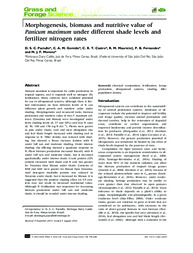Morphogenesis, biomass and nutritive value of Panicum maximum under different shade levels and fertilizer nitrogen rates.
Morphogenesis, biomass and nutritive value of Panicum maximum under different shade levels and fertilizer nitrogen rates.
Autoria: PACIULLO, D. S. C.; GOMIDE, C. A. de M.; CASTRO, C. R. T. de; MAURÍCIO, R. M.; FERNANDES, P. B.; MORENZ, M. J. F.
Resumo: Panicum maximum is important for cattle production in tropical regions, and it responds well to nitrogen (N) fertilization. Many cultivars have exhibited potential for use in silvopastoral systems, although there is limited information on how different levels of N can influence plant growth and nutritive value under shading. Morphogenetic and structural traits, biomass production and nutritive value of two P. maximum cultivars (Tanzania and Massai) were investigated under three shading levels (0, 37 and 58%) and four N rates (0, 50, 100 and 150 mg N dm3). Plants were grown in pots under shade. Leaf and stem elongation rate and leaf blade length increased with shading and in response to N. Tiller density was reduced with shading, but showed a linear increase fashion with N under full sun and moderate shading. Under intense shading, the tillering showed a quadratic response to N. Plant biomass production increased linearly with N under full sun and moderate shade, but it increased quadratically under intense shade. Crude protein (CP) content increased with shade and N and was greater for Tanzania than Massai under shade. Contents of NDF and ADF were greater for Massai than Tanzania. Acid detergent insoluble protein was reduced in Tanzania under shade, but it increased for Massai. It is suggested that the positive shading effect on CP content may not result in increased nutritional value. Although N fertilization was important for increasing biomass production under full sun and moderate shade, it should be avoided under intense shading.
Ano de publicação: 2016
Tipo de publicação: Artigo de periódico
Unidade: Embrapa Gado de Leite
Palavras-chave: Fertilization, Shading, Tiller population density, chemical composition, forage production, silvopastoral systems
Observações
1 - Por padrão são exibidas publicações dos últimos 20 anos. Para encontrar publicações mais antigas, configure o filtro ano de publicação, colocando o ano a partir do qual você deseja encontrar publicações. O filtro está na coluna da esquerda na busca acima.
2 - Para ler algumas publicações da Embrapa (apenas as que estão em formato ePub), é necessário ter, no celular ou computador, um desses softwares gratuitos. Sistemas Android: Google Play Livros; IOS: iBooks; Windows e Linux: software Calibre.
Acesse outras publicações
Acesse a Base de Dados da Pesquisa Agropecuária (BDPA) para consultar o acervo completo das bibliotecas da Embrapa.

